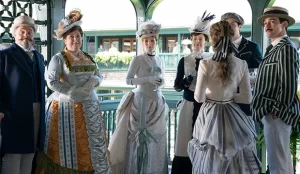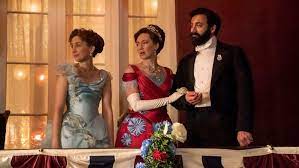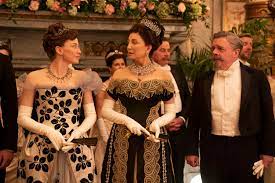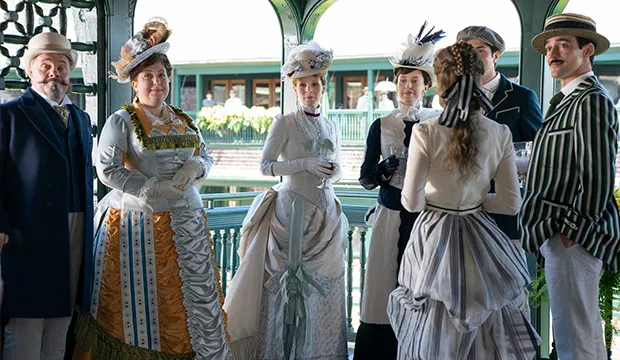In the glittering ballrooms and opulent mansions of 1883 New York City, “The Gilded Age” paints a vivid portrait of a society teetering on the brink of change. Against this backdrop of extravagance and excess, the series delves into the intricate webs of power and privilege that define the lives of the city’s elite. At the forefront of this narrative are Agnes Van Rhijn and Bertha Russell, two women whose contrasting personalities and backgrounds epitomize the tensions between tradition and progress.
Christine Baranski’s portrayal of Agnes Van Rhijn is a tour de force, capturing the character’s steely resolve and unwavering commitment to upholding the status quo. As a member of the old-money aristocracy, Agnes navigates the intricacies of high society with a blend of elegance and ruthlessness, determined to protect her family’s legacy at any cost. In contrast, Carrie Coon’s Bertha Russell represents the rising tide of new money and ambition, challenging the established order with her boldness and ambition. Together, these two formidable women clash and collude in a battle for influence and prestige, shaping the destiny of New York’s social hierarchy.

As the season unfolds, “The Gilded Age” explores themes of class, ambition, and identity against the backdrop of a rapidly changing world. From grand society balls to clandestine power struggles, the series immerses viewers in a world where appearances are everything and alliances are constantly shifting. Yet beneath the veneer of wealth and privilege lies a seething undercurrent of discontent, as characters grapple with the constraints of tradition and the allure of progress.
In its second season, “The Gilded Age” continues to captivate audiences with its blend of historical drama and soap opera spectacle. With its richly drawn characters, sumptuous production design, and juicy plot twists, the series offers a tantalizing glimpse into the glamour and intrigue of America’s Gilded Age. As viewers are drawn deeper into this world of wealth and privilege, they are reminded that beneath the surface lies a society on the cusp of profound transformation.

While the frivolous intrigues of the upper class take center stage, Fellowes does not shy away from exploring the realities faced by the marginalized communities of the era. Characters like Peggy and her mother Dorothy, portrayed respectively by Denée Benton and Audra McDonald, confront the harsh realities of racial discrimination and inequality, adding depth and nuance to the narrative.
Despite the serious themes at play, “The Gilded Age” retains its signature blend of sweetness and spectacle, offering viewers a gratifying dose of escapism amidst the tumult of historical upheaval. From scandalous tea parties to grandiose opera wars, the series revels in the absurdities of the era while never losing sight of its characters’ humanity.

At the heart of the season lies a stellar ensemble cast, whose performances elevate the material to new heights of entertainment. Baranski’s Agnes is a commanding force, while Coon’s Bertha exudes extravagant charm and intimidation. Nathan Lane, as the flamboyant Ward McAllister, delivers yet another scene-stealing performance, infusing the narrative with his trademark wit and charisma.
In its second season, “The Gilded Age” continues to captivate audiences with its blend of history, humor, and heart. Whether it’s the high-stakes drama of the upper class or the poignant struggles of the marginalized, the series offers a compelling portrait of a bygone era filled with opulence and intrigue.
As viewers are swept away into the world of “The Gilded Age,” they are reminded of the enduring allure of Julian Fellowes’ storytelling prowess. With its sumptuous visuals, captivating performances, and irresistibly ludicrous plotlines, the series stands as a testament to the enduring appeal of historical melodrama done right. Grade: A
Follow torrenttip51 for more latest information!

